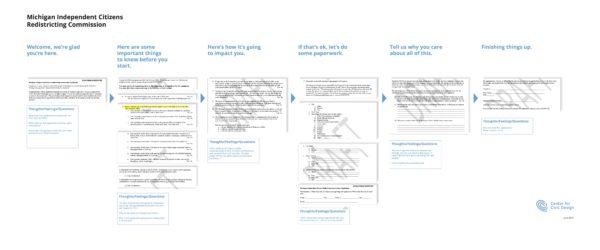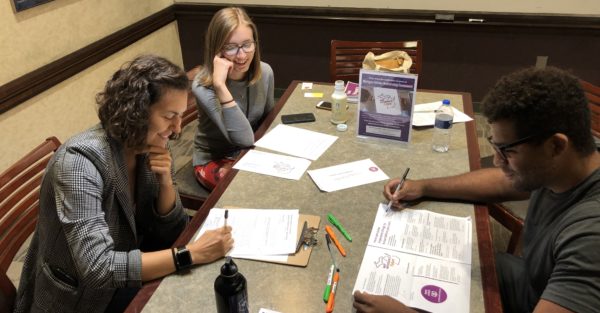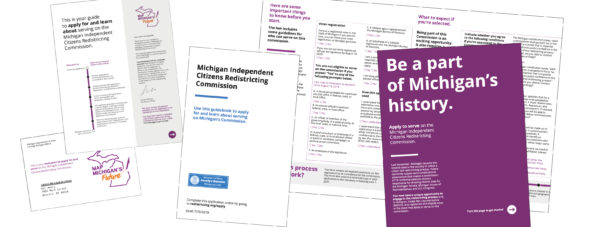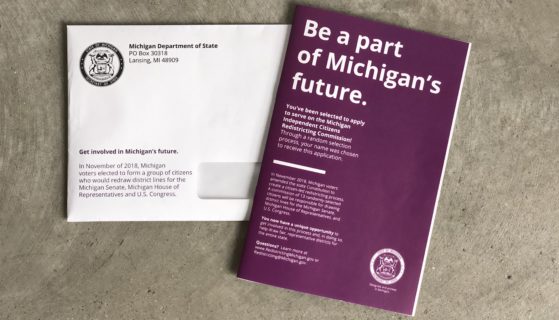An invitation to redistricting
What happens when citizens lead the design of an application for their own effort to redraw district lines? This was not just a form. It was an invitation to take part in democracy in action.
In 2018, Michigan voters elected to form a citizen-led commission to redraw district lines every 10 years (after the census). A first in the state’s history, this was a major step to prevent controversial issues like “gerrymandering” that lead to election district maps advantaging politicians, political parties and incumbents. Michigan is one of only a few states to do this.
With one hurdle accomplished by passing the amendment, another loomed: how to get citizens to apply to be on the commission. To ensure equal representation, the state constitution outlined a complicated set of rules for how the commission would be put together. If these requirements weren’t met, the process wouldn’t work.
While the state constitution outlined a process for contacting citizens through a mailed application, we still had questions. We wondered how we’d capture citizens’ attention, or how we’d help them understand this complicated and exciting opportunity. We wondered how we’d be sure that the 250,000 Michigan residents receiving the mailing wouldn’t think it was junk mail.
As Sally Marsh, Director of Special Projects at the Michigan Secretary of State put it, “I want this to be their golden ticket!” The design of this invitation was an experiment in civic participation in a time when trust in institutions is extremely low.
When we started out, we didn’t really know what would make people excited about this opportunity. The design had almost no precedent to look to for guidance. But plain language told us to create something Michigan residents could find, understand, and use.
The starting point was a 4-page Microsoft Word document that served as the draft of the application. There was no explanation of what the application was, what the applicant would be expected to do, or what redistricting looked like. The text was size 11, Times New Roman, and crowded across 4 pages.

A few challenges
The Center for Civic Design began working on this project in late July 2019. The state constitution required that mailings be distributed a few months later, so we had to work quickly.
We started by thinking about what it would be like to think about applying to be a Commissioner. Everyone needed to understand the rationale behind the application process in order to properly execute the project. To help, we designed an infographic that mapped a user’s experience in completing the application.

(Full-sized PDF of the Journey Map)
For many recipients, this mailing would be the first piece of communication they would read about the redistricting process. While we developed new language with the help of the Secretary of State in some places, we were not able to adjust the legal language of many of the questions in the application. We compensated by using design features like headings and bold to highlight the most important words.
We tested prototypes of the application with users, but we also had to work with the State’s printing facility to determine what could realistically be produced. When we learned that the State’s printing facility did not have the equipment necessary to produce the booklet format that performed successfully in testing the team had to find an external vendor.

Testing, testing
During the course of this project, we tested the application with 44 participants at public libraries in 7 cities. This testing led to 11 different versions of the application and over 100 smaller edits.
We watched people use what we designed. We learned what pages motivated people, which ones they had questions about, and which ones they missed entirely.
The Michigan Secretary of State organized events hosted by local libraries. We set up usability testing sessions at tables and invited patrons to fill out the application as if it was real. Each test session lasted approximately 30 minutes, but in some cases took almost 2 hours.

The first version of the application came in an envelope that included a bright purple and orange Michigan Redistricting logo and a message that “This is your invitation to apply!” This phrasing, according to participants, sounded like something they would find on a coupon. They said they associated the logo with advertisements or, even worse, junk mail. The return address clearly said “Michigan Secretary of State” but many missed it. One participant said, “I’d either put it on the rainy day pile or throw it away.”
Because our goal was for people to open the envelope and read about the commission, we redesigned the envelope to include the formal Secretary of State’s seal and a friendly message to “get involved in Michigan’s future.” It also included a brief explanation of the constitutional amendment right on the front of the envelope. These changes proved successful.

Inside the envelope, applicants found a short booklet-style application that walked them through each step of the application process. The moderator’s guide we designed included interview-style questions. We asked each participant what they knew about “Prop 2,” the ballot proposal for the redistricting amendment. Most participants were not aware of what Prop 2 was. Even fewer knew what “redistricting” meant. We realized this was an educational gap that the application had to fill.
We also learned that a visual timeline of the application process and a message from the Secretary of State was not capturing anyone’s attention. One person said, “why do we need redistricting and what’s the connection to a commission?” It was clear we needed to explain the importance of applying and make it feel exciting.
This resulted in a bold, colorful cover and a clear headline message that provided simple background information. Based on suggestions from participants, the application cover repeats the same seal from the envelope.
On the first two pages of the application, we answered two key questions asked by participants: what is redistricting and what does the role of the commissioner look like.

Responses from applicants
Two weeks after the application had been mailed, the Department of State had received over 1,000 returned applications.
It turned out that invitations get responses. After the mass mailing, thousands of Michigan residents replied. They not only completed the application but sent enthusiastic and heartfelt responses in their envelopes.
As of late March, over 3,500 applications have been processed. The Michigan Department of State has run workshops in 11 locations around the state, and it’s paid off. Currently, people from 82 of Michigan’s 83 counties have submitted applications.
Finally, including Michigan residents from across the state in the co-creation of this application means that its applicants will be more diverse. In turn, a more diverse commission will redraw district lines that better reflect the lives of all Michigan residents. We’re excited to have played a small part in the realization of this important amendment.
More reading
MichiganRedistricting.org – the website for the Independent Citizens Redistricting Commission application and selection process
See who’s applying. The Michigan Secretary of State regularly publishes data on their website
Download the paper application, also available in Spanish and Arabic

